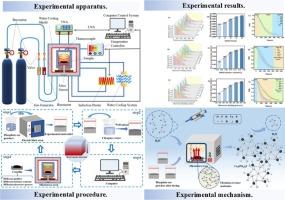微波干燥技术对磷矿干燥动力学的影响
IF 4.6
2区 工程技术
Q2 ENGINEERING, CHEMICAL
引用次数: 0
摘要
针对传统磷酸盐干燥方法能耗高、产品质量不稳定等技术瓶颈,提出了一种基于微波辐射的节能脱水方法。研究了初始含水率、初始质量和微波功率对磷矿石干燥动力学的影响。结果表明,微波功率、含水率、初始质量与干燥速率呈正相关。建立了微波作用下磷矿干燥动力学模型,包括二次模型、Page模型、修正Page模型和Wang-Singh模型。结果表明,修正页模型具有较高的拟合精度。傅里叶变换红外(FT-IR)光谱分析表明,经过微波处理后,样品中对应水分的红外吸收峰强度明显降低,证明了水分的有效去除。此外,在光谱中的其他特征吸收峰没有观察到移位,证实处理过程没有改变样品的主要化学成分。这一突破克服了传统热干燥常常导致矿物晶格破坏的局限性。由Arrhenius方程求出的活化能(13.1872 g/W)揭示了微波干燥过程中水分解吸的机理。本研究为微波干燥技术在磷矿选矿领域的应用提供了理论和实证支持。本文章由计算机程序翻译,如有差异,请以英文原文为准。

The impact of microwave drying technology on the drying kinetics of phosphate ore
To address the technical bottlenecks of traditional phosphate drying methods, including high energy consumption and unstable product quality, this paper proposes an energy-saving dehydration method based on microwave radiation. The effects of initial moisture content, initial mass, and microwave power on the drying kinetics of phosphate ore were investigated. The results show that microwave power, moisture content, and initial mass are positively correlated with drying rate. Four kinetic models were constructed to analyze the drying process of phosphate ore under microwave action, including Quadratic, Page, Modified Page, and Wang-Singh models. The results indicate that the Modified Page model has a higher fitting accuracy. Fourier Transform Infrared (FT-IR) spectroscopy analysis shows that after microwave treatment, the intensity of the infrared absorption peak corresponding to water in the sample significantly decreased, proving effective removal of moisture. Additionally, no shift was observed in other characteristic absorption peaks in the spectra, confirming that the treatment process did not alter the primary chemical composition of the sample. This breakthrough overcomes the limitations of traditional thermal drying, which often leads to the destruction of the mineral lattice. The activation energy (13.1872 g/W) determined from the Arrhenius equation reveals the mechanism of moisture desorption during microwave drying. This study provides both theoretical and empirical support for the application of microwave drying technology in the field of phosphate mineral processing.
求助全文
通过发布文献求助,成功后即可免费获取论文全文。
去求助
来源期刊

Powder Technology
工程技术-工程:化工
CiteScore
9.90
自引率
15.40%
发文量
1047
审稿时长
46 days
期刊介绍:
Powder Technology is an International Journal on the Science and Technology of Wet and Dry Particulate Systems. Powder Technology publishes papers on all aspects of the formation of particles and their characterisation and on the study of systems containing particulate solids. No limitation is imposed on the size of the particles, which may range from nanometre scale, as in pigments or aerosols, to that of mined or quarried materials. The following list of topics is not intended to be comprehensive, but rather to indicate typical subjects which fall within the scope of the journal's interests:
Formation and synthesis of particles by precipitation and other methods.
Modification of particles by agglomeration, coating, comminution and attrition.
Characterisation of the size, shape, surface area, pore structure and strength of particles and agglomerates (including the origins and effects of inter particle forces).
Packing, failure, flow and permeability of assemblies of particles.
Particle-particle interactions and suspension rheology.
Handling and processing operations such as slurry flow, fluidization, pneumatic conveying.
Interactions between particles and their environment, including delivery of particulate products to the body.
Applications of particle technology in production of pharmaceuticals, chemicals, foods, pigments, structural, and functional materials and in environmental and energy related matters.
For materials-oriented contributions we are looking for articles revealing the effect of particle/powder characteristics (size, morphology and composition, in that order) on material performance or functionality and, ideally, comparison to any industrial standard.
 求助内容:
求助内容: 应助结果提醒方式:
应助结果提醒方式:


